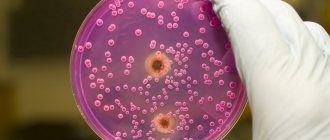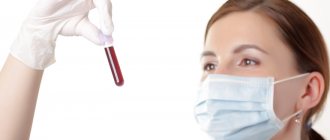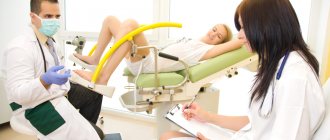General analysis (coprogram)
- 2 days before collecting biomaterial, discard tomatoes, tomato juice, pasta, beets, blueberries, pomegranates and other vegetables and fruits containing dyes.
- For 3 days, stop taking antibiotics, laxatives, and drugs that cause changes in intestinal motor function. Do not use rectal suppositories, ointments, or oils.
- Do not eat exotic fruits, vegetables and foods that are not typical for your diet as a whole. Do not overeat, exclude fatty, spicy, pickled foods.
- If you are taking medications containing iron and bismuth, they must be discontinued 2 days before stool collection.
Attention. After radiography with a contrast agent (barium), collect feces for coprogram no earlier than 7–10 days after the examination. Women are not recommended to take the test during menstruation.
Procedure for collecting stool:
Collect stool for examination in the morning, on an empty stomach. If this is difficult, you can prepare the sample in advance, but no more than 8 hours before submitting it to the laboratory. In this case, store the sample in the refrigerator (do not freeze!).
- Carry out hygiene procedures and first urinate in the toilet and flush.
- Place sterile paper (or an ironed sheet) or a disposable plastic plate in the bowl or bottom of the toilet and perform a bowel movement.
- Collect feces immediately after defecation from different places in a single portion with a special spoon mounted in the lid of a plastic container in a volume of 1–2 g (no more than 1/3 of the container’s volume). Avoid contact with urine and pieces of undigested food.
- Deliver the sample to the laboratory on the day of collection. Before delivering the sample to the laboratory, the container with stool should be kept in the refrigerator at 2–4 °C. Storage at 2-8 °C is allowed - up to 72 hours.
Do periods affect results?
For females, menstruation begins when their body is ready to give birth to children. If we consider in more detail whether it is possible to take a urine test during menstruation, then it all depends on the procedure itself. The results of examinations are primarily influenced by the period (phase) of the menstrual cycle. Therefore, if possible, doctors advise donating biomaterial not at the beginning or end, but in the very middle of the cycle.
Urine is biological components processed by the kidneys. It is excreted from the body through the genitourinary tract. Analysis of the composition of urine indicates the level of metabolism, identifies various cells, microorganisms, bacteria and enzymes.
As a rule, urine analysis is of the following types:
- daily or total (determines the volume of glucose, urea and protein released throughout the day);
- clinical (allows you to determine the amount of bacteria, protein, glucose and other cellular elements in the urine);
- biochemical (determines the level of magnesium, sodium, potassium, amylase, phosphorus, creatinine, urea, uric acid, etc.);
- according to Nechiporenko (determines pathologies of the kidneys and urinary tract);
- according to Zimnitsky (allows you to determine how correctly the kidneys are working);
- according to Amburge (allows you to assess the condition of the urinary system).
The results of studies conducted during the procedure may be distorted, since the urethra in women enters the vaginal canal, through which blood comes out. The concentration and color of urine may change throughout the day. The most accurate indicators can be achieved by collecting a morning portion of urine.
You can take a urine test during menstruation, but you should remember that the urine will change color and composition due to the ingress of blood cells into it. These changes may lead to an incorrect diagnosis. In cases where it is necessary to be examined during the menstrual period, it is important to follow special rules for collecting biomaterial. But for the accuracy of the result, in any case, it will be necessary to repeat the studies after the end of the critical days.
Dysbacteriosis, intestinal group
To obtain the correct result, material for research is taken before the start of antibacterial therapy or in the intervals between courses of treatment, but not earlier than 2 weeks after its completion.
Attention Do not collect feces from diapers. For infants, collect material from a sterile diaper or pre-ironed onesies. If liquid feces are collected, it can be collected by placing an oilcloth under the baby.
Collection rules
- Feces should be collected in the morning, on an empty stomach.
- Carry out hygiene procedures and first urinate in the toilet and flush.
- Place sterile paper (or an ironed sheet) or a disposable plastic plate in the bowl or bottom of the toilet and perform a bowel movement.
- Collect feces immediately after defecation from different places in a single portion with a special spoon mounted in the lid of a plastic container in a volume of 1–2 g (no more than 1/3 of the container’s volume). Avoid contact with urine and pieces of undigested food.
- Deliver to the laboratory on the day of collection.
The sample can be stored for no more than 2 hours at room temperature; no more than 6 hours at 2-8 °C, more than 6 hours - frozen.
Hemoglobin in type 2 diabetes: how to raise low levels?
Have you been struggling with CHOLESTEROL for many years without success?
Head of the Institute: “You will be amazed at how easy it is to lower your cholesterol just by taking it every day.
Hemoglobin in the body is responsible for transporting oxygen from the lungs to the tissues. It is found in red blood cells - erythrocytes. With a lack of its content in the blood, anemia occurs.
For diagnosis, blood is examined for red blood cells, platelets, leukocytes and hemoglobin.
Our readers successfully use Aterol to lower cholesterol. Seeing how popular this product is, we decided to bring it to your attention. Read more here...
The hemoglobin norm for men is 130-160 g/l, for women 120-140 g/l. In diabetes mellitus, anemia develops as a complication of insufficient kidney function and requires treatment with a special drug - erythropoietin.
Signs of low hemoglobin levels
Manifestations of decreased hemoglobin in diabetes are similar to the general signs of anemia. You can suspect that hemoglobin is low based on the following signs:
- Dizziness.
- Paleness of the skin and mucous membranes.
- Weakness and shortness of breath with minor exertion.
- Cardiopalmus.
- Constant fatigue.
- Impaired attention and memory.
- Increased sensitivity to cold.
- Weight loss.
- Insomnia.
- Dry skin, cracks in the corners of the mouth.
The reasons for the decrease in hemoglobin in diabetes mellitus may be different. In severe diabetes, kidney tissue loses its functions and is replaced by rough connective tissue.
In this case, the hormone erythropoietin, which the kidneys produce, does not reach the bone marrow. The maturation of red blood cells and their production in the bone marrow decreases, which means there is less hemoglobin in the blood. Platelets may be normal.
According to statistics, every fourth patient with diabetes suffers from anemia. In addition to the renal factor, iron deficiency, destruction of red blood cells, chronic bleeding (for example, with hemorrhoids or heavy periods), and lack of oxygen lead to a decrease in hemoglobin.
All of these factors in healthy people activate the production of red blood cells and hemoglobin, but this does not happen in diabetes mellitus.
Therefore, the course of anemia in such patients is more severe than in other diseases.
What concomitant diseases can lead to anemia?
In addition to diabetes itself, a decrease in hemoglobin can be caused by the following pathologies:
- Deficiency of microelements and vitamins - iron, vitamin B12, folic acid or proteins. It occurs with a monotonous diet, or with an increased need during growth, pregnancy, or heavy physical activity.
- Acute or chronic infections (diphtheria, scarlet fever, tuberculosis, influenza)
- Bleeding due to injuries or chronic blood loss (heavy periods due to gynecological diseases, uterine or intestinal polyps, ulcers, erosions of the stomach or intestines, tumors)
- Oncological diseases.
- Kidney diseases (nephritis, autoimmune lesions)
Read more Intrauterine device removal
What does low hemoglobin lead to in diabetes? In addition to the visible signs of anemia, which reduce the quality of life in diabetics (weakness, pallor, dizziness), oxygen deficiency leads to the development of damage to internal organs. The most common pathologies are:
- Development of heart failure.
- Progression of coronary heart disease.
- Increased manifestations of damage to small vessels of the retina and kidneys.
- Damage to the nervous system.
This course of anemia occurs because organs with diabetes mellitus already experience a lack of nutrition, so it becomes difficult for the body to compensate for the addition of oxygen starvation.
The most detrimental thing is a lack of oxygen and glucose for the heart and brain.
Therefore, heart attacks and strokes often develop against this background.
How to diagnose anemia in diabetes mellitus
The main indicator of anemia is low hemoglobin in the blood. To determine it, it is enough to carry out a general analysis. But to select a method of treating anemia in diabetics, additional diagnostic tests are performed. Platelets, iron levels, leukocytes, and red blood cells are examined.
Platelets decrease in iron deficiency anemia and liver disease. The destruction of red blood cells and inflammatory processes increase their content.
To determine hidden blood loss, a stool test is performed. To exclude inflammation and tumors of the digestive system, blood is examined for C-reactive protein.
Treatment of anemia in diabetics
If anemia of renal origin is confirmed, then hemoglobin can be quickly increased only with erythropoietin. The drug is used under medical supervision and administered intravenously or subcutaneously. Constant blood monitoring is required. During treatment, a deficiency of iron and vitamins develops, therefore, along with medications, a special diet is indicated.
To treat anemia with low iron levels, it is used in combination with vitamins or as a stand-alone drug. The most common medications are iron preparations (Ferroplex, Totema, Actiferrin, Ferrum Lek, Sorbifer Durules, Ferrum Lek, Tardiferon).
Vitamin complexes with a high iron content - Vitrum, Centrum from A to Zn, AlfaVit Classic, Complivit Iron.
With diseases of the stomach or a vegetarian diet, a lack of vitamin B 12, which is involved in hematopoiesis, develops. In such cases, it is prescribed to take it in tablets or intramuscular injections of cyanocobalamin.
Lack of folic acid and protein usually does not require significant drug correction and is easily eliminated with a proper diet.
What foods increase hemoglobin
To improve your well-being and normalize metabolic processes, you need to know how to increase hemoglobin in diabetes mellitus. To do this, you need to include the following products in your diet:
- Beef and chicken liver.
- Veal and beef.
- Turkey.
- Egg yolk.
- Squid, mussels.
- Legumes – beans, green peas
- Parsley, spinach.
- Sesame, sunflower and pumpkin seeds.
- Walnuts.
- Blueberry.
- Apricots and plums.
- Dried fruits
- Raspberries.
- Buckwheat and wheat bran.
All of these foods contain a lot of iron, but it is best absorbed from animal products. Ascorbic acid from rosehip decoction, apple or blackcurrant juice enhances its absorption, and coffee, tea and dairy products inhibit it.
Legumes are rich in iron and protein, but for better absorption, you need to soak them overnight and then rinse them. This removes phytic acid, which inhibits iron absorption.
You can prepare a mixture of dried fruits and walnuts, chopped in a blender, and lemons. Everything must be taken in equal parts. Take a tablespoon in the morning on an empty stomach, washed down with rosehip decoction.
Diet to increase hemoglobin
Diabetes mellitus requires special dietary nutrition, and dietary dishes for diabetics. You can raise your hemoglobin level using this sample menu:
Breakfast: oatmeal with water and steamed prunes, apple juice.
Second breakfast: bread with bran, Adyghe cheese, blackcurrant compote with xylitol.
Lunch: lentil and carrot soup, chicken liver, lettuce, tomato juice.
Dinner: boiled squid salad with herbs, buckwheat porridge, rosehip infusion.
Folk remedies for increasing hemoglobin Herbalists and traditional healers know how to increase hemoglobin in natural ways:
- Take a teaspoon of pollen in the morning.
- Prepare an infusion of nettle and yarrow. Take a teaspoon of each herb and pour boiling water over it. Leave for 25 minutes and drink a third of a glass twice a day.
- Instead of tea, brew fireweed leaf.
- Drink half a glass of raw potato juice before meals. Only freshly prepared ones are used.
- Infusion of meadow clover. Ten flower heads per 200 ml of boiling water. Leave for an hour. Drink 30 ml 4 times a day.
- Mix equal parts of rosehip and rowan. Pour a tablespoon of the crushed mixture with boiling water (250 ml) in a thermos overnight. In the morning before breakfast, drink half a glass.
- Eat half a pomegranate every day.
- Sprout wheat, grind and take a tablespoon or add to porridge.
Prevention of anemia in diabetes
You can prevent such a serious condition as anemia if you regularly undergo a full examination of the body, control your diet and medications, be sure to walk in the fresh air for at least half an hour a day, do light gymnastics, swimming, and yoga.
Quitting smoking and alcohol helps reduce the risk of liver and vascular damage, and therefore avoid the development of diabetes complications. Losing body weight normalizes fat metabolism and alleviates diabetes.
What is glycated hemoglobin? In diabetes mellitus, there is an indicator of hemoglobin content, a high level of which is unfavorable. This is the level of glycated (glucose-bound) hemoglobin.
Red blood cells have a normal lifespan of three months, so its assessment will reflect the average blood sugar readings over 120 days. The norm is 4-6%. Anything above 6.5% is diabetes, from 6 to 6.5% is prediabetes, below 4% is hypoglycemia (low sugar). Low levels can occur due to an overdose of insulin or glucose-lowering drugs for type 2 diabetes.
Why do you need to measure the level of glycated hemoglobin? Measuring blood glucose levels reflects the state of carbohydrate metabolism at the time of measurement. For type 2 diabetes, measurements are often taken once a month.
And in order to find out how correctly the diet and medications have been chosen, you need to know the average daily indicator.
Thus, the study of glycated hemoglobin reflects the course of diabetes and the level of compensation for increased sugar. It needs to be examined at least once every three months. This does not replace blood glucose testing, which should be done daily.
In order to lower the level of glycated hemoglobin, you need to be regularly examined, take prescribed treatment and eat right. An active lifestyle is a factor that lowers the level of this protein. Elena Malysheva will continue the conversation about the problem of hemoglobin in the video in this article.
Protozoa and helminth eggs
To obtain the most reliable results, three stool examinations are recommended with an interval of 3–7 days.
Attention You cannot collect stool earlier than 3 days after an enema, an X-ray examination of the stomach and intestines, or a colonoscopy. The day before, do not take laxatives and drugs that affect intestinal motility (belladonna, pilocarpine), activated carbon, iron, copper, bismuth, barium sulfate, use fat-based rectal suppositories. Women should not collect stool during menstruation.
Collection rules
- Feces should be collected in the morning, on an empty stomach. If this is difficult, you can prepare the sample in advance, but no more than 8 hours before submitting it to the laboratory. In this case, the sample should be stored in the refrigerator (do not freeze!).
- Carry out hygiene procedures and first urinate in the toilet and flush.
- Place sterile paper (or an ironed sheet) or a disposable plastic plate in the bowl or bottom of the toilet and perform a bowel movement.
- Collect feces immediately after defecation from different places in a single portion with a special spoon mounted in the lid of a plastic container in a volume of 1–2 g (no more than 1/3 of the container’s volume). Avoid contact with urine, water and pieces of undigested food;
- Deliver to the laboratory on the day of collection.
Rules for collecting urine during menstruation
Bloody discharge makes it difficult to accurately evaluate a urine test and is therefore considered undesirable for this medical examination. If the examination issue is not urgent, then it would be advisable to postpone it until the end of the regulation. If you definitely need to take a urine test during menstruation, you should familiarize yourself with some of the features of collecting urine on menstrual periods.
In special cases, when research is urgently needed, the doctor can use a catheter, which is inserted into the woman’s urinary canal and eliminates the possibility of various impurities from the vagina getting into the urine. If urine collection is carried out at home, it is also recommended to follow some rules to ensure the reliability of the result.
The scheme for donating urine during menstruation looks like this:
- Before collecting urine, you should disinfect your hands and insert a gynecological tampon into the vaginal canal.
- Wash the genitals with warm water without hygiene products and dry with a napkin.
- For urine, use a special sterile container with an airtight lid.
- It is recommended to donate collected urine within a maximum of two hours after urination.
If urine is collected according to all the rules, then the research result will be accurate. If any points are not observed, there is a risk of distortion of the survey result, and as a result, its incorrect interpretation. In any case, you should notify the doctor about the available critical days, and take a second test after their completion.
Bacteriology
To obtain a reliable result, material for research is taken before the start of antibacterial therapy or in the intervals between courses of treatment, but not earlier than 2 weeks after its completion.
- 3-4 days before the study, it is necessary to stop taking laxatives, castor and petroleum jelly and stop administering rectal suppositories.
Attention: Feces obtained after an enema, as well as after taking barium (during an X-ray examination), are not suitable for research.
Collection rules
- Feces should be collected in the morning, on an empty stomach.
- Carry out hygiene procedures and first urinate in the toilet and flush.
- Place sterile paper (or an ironed sheet) or a disposable plastic plate in the bowl or bottom of the toilet and perform a bowel movement.
- Collect feces immediately after defecation from different places in a single portion with a special spoon mounted in the lid of a plastic container in a volume of 1–2 g (no more than 1/3 of the container’s volume). Avoid contact with urine and pieces of undigested food.
- Deliver to the laboratory on the day of collection.
Is it possible to donate blood from a vein during menstruation?
When taking blood from a vein during menstruation, the rules are identical to the classical procedure for taking a general analysis of biomaterial. As part of a possible scheduled test, it is better to postpone it by one week. If it is impossible to carry out such a procedure, it is imperative to notify the diagnostician about the presence of menstruation in order, if possible, to correct potential deviations from the norm, taking into account the physiological characteristics of the fair sex.
First of all, blood from a vein will have a different coagulation parameter compared to normal. This could theoretically indicate a number of serious problems with the body in the absence of information about the presence of the above-described factor.
In addition, it is worth considering that venous blood is sometimes used to search for cancer markers as part of a comprehensive diagnosis of leukemia and other diseases of the hematological spectrum. In this situation, the presence of an active phase of menstruation almost always leads to false-positive results.
PCR studies
Collection rules
- Feces should be collected in the morning, on an empty stomach.
- Carry out hygiene procedures and first urinate in the toilet and flush.
- Place sterile paper (or an ironed sheet) or a disposable plastic plate in the bowl or bottom of the toilet and perform a bowel movement.
- Collect feces immediately after defecation from different places in a single portion with a special spoon mounted in the lid of a plastic container in a volume of 1–2 g (no more than 1/3 of the container’s volume). Avoid contact with urine and pieces of undigested food.
- Deliver to the laboratory on the day of collection.
How do periods affect test results?
If you have an urgent visit to the laboratory, the question arises: “Do menstruation affect the result of a urine test?” There is no definite answer, because the indicators largely depend on the correctness of urine collection. Particles of epithelium, bacteria, mucus and red blood cells that get into the urine can distort the result or signal an existing disease. When examining urine taken during menstruation, the doctor may make erroneous diagnoses, such as:
- angina and other heart diseases;
- insulin deficiency - diabetes;
- liver diseases;
- kidney pathologies.
This is due to a change in the physicochemical properties of urine during the regulative period, and with an increase in its specific gravity and the number of leukocytes. Epithelium found in urine can be interpreted by a doctor as a sign of a tumor. This component also indicates jaundice, urolithiasis, cystitis and drug intolerance. Information about the presence of bacteria in the urine may be erroneous, and, as a result, a false diagnosis of pyelonephritis, urethritis or cystitis.
Culture for microflora and sensitivity to antibiotics
3-4 days before the study, it is necessary to stop taking laxatives, castor and vaseline oil, and stop administering rectal suppositories. Feces obtained after an enema, as well as after taking barium (during X-ray examination) are not accepted for examination!
Attention: Feces are collected before starting treatment with antibacterial and chemotherapy drugs.
Collection rules
- First urinate in the toilet and flush.
- Place sterile paper (or an ironed sheet) or a disposable plastic plate in the bowl or bottom of the toilet and perform a bowel movement.
- Collect feces immediately after defecation from different places in a single portion with a special spoon mounted in the lid of a plastic container in a volume of 1–2 g (no more than 1/3 of the container’s volume). Avoid contact with urine and pieces of undigested food.
- Deliver to the laboratory on the day of collection. If it is impossible to quickly deliver the sample to the laboratory, you can store it in the refrigerator for no more than 4 hours at 2-8 °C.
Useful video
Watch this video about whether it is possible to do an ultrasound during menstruation:
A spot may appear instead of menstruation for completely safe reasons, or against the background of a disease. Also, during pregnancy, it can indicate pathologies and the threat of failure.
Throughout the menstrual cycle, certain hormones predominate. They are responsible for ovulation, the ability to conceive, as well as general problems. What are the hormones during menstruation?
Often, periods with the IUD are the same as without it. However, sometimes an individual reaction may be the opposite - bleeding will begin. When is the best time to remove the coil? What are the normal periods?
Quite often thrush occurs during menstruation. This is due both to changes in hormonal levels and to a decrease in general immunity. What to do with thrush during menstruation?
Infectious disease doctor, hepatologist, parasitologist. Deputy chief physician of the O-Tri clinic.
Graduate of the Military Medical Academy named after. S.M.Kirova.
She deals with a wide range of infectious and parasitic human diseases, dispensary observation of those who have recovered from the disease, provides consultations to pregnant women with concomitant infectious pathologies, and treatment of viral hepatitis B and C.
In her work she is guided by the latest scientific achievements and developments in the field of medicine, legislation and requirements. Uses modern medicines from the standpoint of evidence-based medicine. If necessary, involves specialized specialists in the interests of the patient.
Phone number for registration: +. Reception is conducted at the address: St. Petersburg, st. Shpalernaya, 34, medical (consultation cost 1600 rubles).
For carbohydrates
- Carry out hygiene procedures and first urinate in the toilet and flush.
- Place sterile paper (or an ironed sheet) or a disposable plastic plate in the bowl or bottom of the toilet and perform a bowel movement.
- Collect feces immediately after defecation from different places in a single portion with a special spoon mounted in the lid of a plastic container in a volume of 1–2 g (no more than 1/3 of the container’s volume). Avoid contact with urine and pieces of undigested food.
- Deliver the sample to the laboratory within 4 hours.
Attention Storing a stool sample for more than 4 hours, including in the refrigerator, is not allowed.
Donation during menstruation
Donation is a great benefit for society, allowing to save hundreds and thousands of lives of patients who need transfusion of the designated biomaterial. As practice shows, in the majority of cases it is women who become donors, since men try to avoid such medical manipulations.
Donating blood during menstruation is prohibited for the following reasons:
- Impact on health. For many women, the onset of menstruation is associated with deterioration in health, weakness, irritability, and so on. Taking a sufficiently large amount of biomaterial, along with physiological loss of biofluid, can provoke fainting, prolonged loss of consciousness and other negative conditions.
- Changes in blood composition. During menstruation, a woman's body composition changes. The levels of hemoglobin and red blood cells are critical in this regard.
It should be understood that for the most part, the ban on donating blood during menstruation is relative in nature and is associated with the impact on the woman’s well-being. In addition, the collected biomaterial has deviations in a number of important indicators, but is still suitable for use. In this case, the collected liquid is mainly used for plasma and is not suitable for direct whole transfusion.
Accordingly, modern medical experts recommend that when making a donation, wait at least 6 days after the end of menstruation, and then carry out the planned event.










